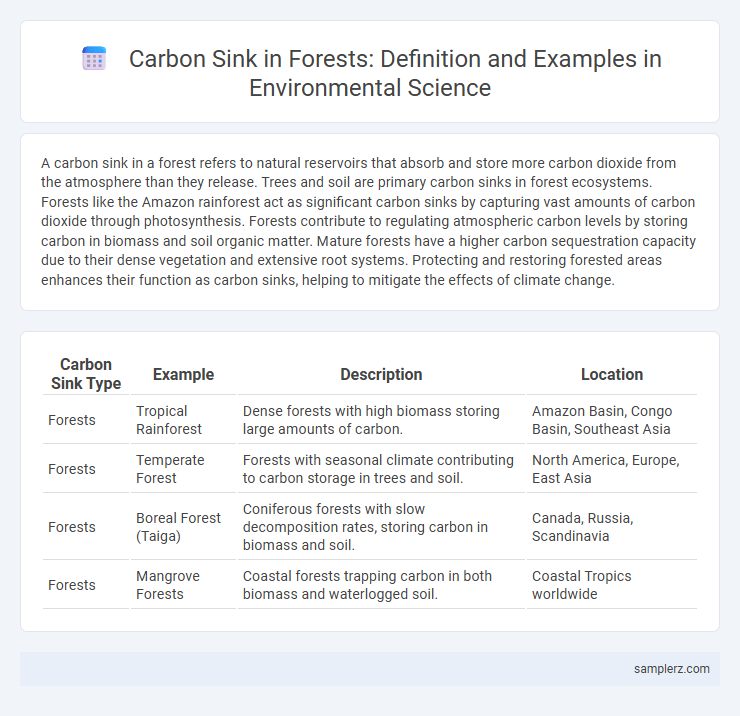A carbon sink in a forest refers to natural reservoirs that absorb and store more carbon dioxide from the atmosphere than they release. Trees and soil are primary carbon sinks in forest ecosystems. Forests like the Amazon rainforest act as significant carbon sinks by capturing vast amounts of carbon dioxide through photosynthesis. Forests contribute to regulating atmospheric carbon levels by storing carbon in biomass and soil organic matter. Mature forests have a higher carbon sequestration capacity due to their dense vegetation and extensive root systems. Protecting and restoring forested areas enhances their function as carbon sinks, helping to mitigate the effects of climate change.
Table of Comparison
| Carbon Sink Type | Example | Description | Location |
|---|---|---|---|
| Forests | Tropical Rainforest | Dense forests with high biomass storing large amounts of carbon. | Amazon Basin, Congo Basin, Southeast Asia |
| Forests | Temperate Forest | Forests with seasonal climate contributing to carbon storage in trees and soil. | North America, Europe, East Asia |
| Forests | Boreal Forest (Taiga) | Coniferous forests with slow decomposition rates, storing carbon in biomass and soil. | Canada, Russia, Scandinavia |
| Forests | Mangrove Forests | Coastal forests trapping carbon in both biomass and waterlogged soil. | Coastal Tropics worldwide |
Introduction to Forest Carbon Sinks
Forest carbon sinks play a critical role in mitigating climate change by absorbing and storing atmospheric carbon dioxide through photosynthesis. Mature forests, such as temperate and tropical rainforests, serve as significant carbon reservoirs by sequestering carbon in biomass, soil, and dead organic matter. Effective management and conservation of these forest ecosystems enhance their capacity to offset greenhouse gas emissions and support global carbon balance.
Role of Trees in Carbon Storage
Trees act as vital carbon sinks by absorbing atmospheric carbon dioxide during photosynthesis and storing it in their biomass, including trunks, branches, leaves, and roots. Forests worldwide sequester approximately 2.6 billion tonnes of carbon annually, significantly reducing greenhouse gas concentrations. Mature trees, with their extensive root systems and dense wood, provide long-term carbon storage, helping mitigate climate change impacts.
Old-Growth Forests as Carbon Reservoirs
Old-growth forests serve as vital carbon sinks, storing large amounts of carbon in their biomass and soil accumulated over centuries. These ecosystems sequester significantly more carbon compared to younger forests due to their complex structure and undisturbed conditions. Preserving old-growth forests is essential for mitigating climate change by maintaining their capacity to act as long-term carbon reservoirs.
Mangrove Forests: Unique Coastal Carbon Sinks
Mangrove forests are exceptional carbon sinks due to their dense root systems and ability to store large amounts of organic carbon in both soil and biomass. These coastal ecosystems sequester carbon at rates up to four times higher than terrestrial forests, making them vital in mitigating climate change. Their preservation supports biodiversity while maintaining carbon storage in coastal zones vulnerable to erosion and sea-level rise.
Temperate Rainforests: High-Capacity Carbon Absorbers
Temperate rainforests serve as high-capacity carbon sinks, absorbing significant amounts of atmospheric CO2 through dense biomass and deep soil layers. These forests, characterized by species such as Douglas fir and Sitka spruce, store carbon both above and below ground, playing a crucial role in mitigating climate change. Their ability to sequester carbon over long periods makes them vital ecosystems in global carbon management strategies.
The Impact of Reforestation on Carbon Sequestration
Reforestation significantly enhances carbon sequestration by restoring degraded forest ecosystems that act as vital carbon sinks. Young, fast-growing trees in reforested areas absorb large quantities of atmospheric CO2, storing carbon in biomass and soil. Studies indicate that reforested lands can sequester up to 10 metric tons of carbon per hectare annually, effectively mitigating climate change impacts.
Forest Soil: An Overlooked Carbon Sink
Forest soil acts as a significant carbon sink by storing organic carbon derived from decomposed plant material and root exudates. This hidden reservoir holds more carbon than the forest vegetation above ground, playing a crucial role in mitigating climate change. Protecting and managing forest soils enhances their capacity to sequester carbon and supports overall ecosystem health.
Peatland Forests and Carbon Retention
Peatland forests act as significant carbon sinks, storing vast amounts of carbon in their waterlogged, organic-rich soils. These ecosystems retain carbon for thousands of years by slowing decomposition and preventing the release of greenhouse gases. Effective conservation of peatland forests is crucial for mitigating climate change through long-term carbon retention.
Threats to Forest Carbon Sinks
Forest carbon sinks, primarily composed of mature trees and soil organic matter, play a critical role in sequestering atmospheric CO2 to mitigate climate change. Major threats to these sinks include deforestation, forest degradation, and increased incidence of wildfires, which release stored carbon back into the atmosphere. Climate change-induced stressors, such as prolonged droughts and pest infestations, further compromise the stability and carbon storage capacity of forest ecosystems.
Conservation Strategies for Enhancing Forest Carbon Storage
Protecting old-growth forests preserves vast amounts of carbon sequestered in biomass and soil, acting as critical natural carbon sinks. Implementing selective logging and sustainable forest management maintains forest structure and promotes regeneration, enhancing carbon storage capacity. Restoration of degraded forest lands through reforestation and afforestation increases carbon capture and supports biodiversity conservation simultaneously.

example of carbon sink in forest Infographic
 samplerz.com
samplerz.com